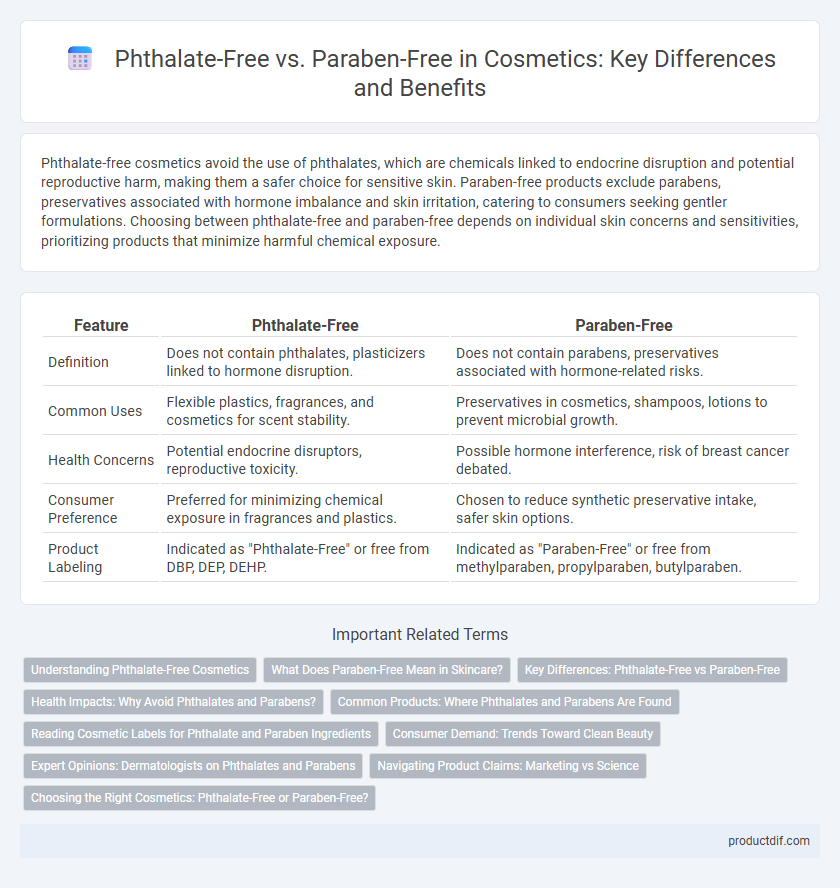Phthalate-free cosmetics avoid the use of phthalates, which are chemicals linked to endocrine disruption and potential reproductive harm, making them a safer choice for sensitive skin. Paraben-free products exclude parabens, preservatives associated with hormone imbalance and skin irritation, catering to consumers seeking gentler formulations. Choosing between phthalate-free and paraben-free depends on individual skin concerns and sensitivities, prioritizing products that minimize harmful chemical exposure.
Table of Comparison
| Feature | Phthalate-Free | Paraben-Free |
|---|---|---|
| Definition | Does not contain phthalates, plasticizers linked to hormone disruption. | Does not contain parabens, preservatives associated with hormone-related risks. |
| Common Uses | Flexible plastics, fragrances, and cosmetics for scent stability. | Preservatives in cosmetics, shampoos, lotions to prevent microbial growth. |
| Health Concerns | Potential endocrine disruptors, reproductive toxicity. | Possible hormone interference, risk of breast cancer debated. |
| Consumer Preference | Preferred for minimizing chemical exposure in fragrances and plastics. | Chosen to reduce synthetic preservative intake, safer skin options. |
| Product Labeling | Indicated as "Phthalate-Free" or free from DBP, DEP, DEHP. | Indicated as "Paraben-Free" or free from methylparaben, propylparaben, butylparaben. |
Understanding Phthalate-Free Cosmetics
Phthalate-free cosmetics avoid the use of synthetic chemicals known to disrupt endocrine function and pose health risks, unlike some traditional cosmetic ingredients. These products emphasize safer formulations by excluding phthalates, which are commonly used to enhance fragrance longevity and plasticity but have raised concerns about reproductive toxicity. Consumers seeking phthalate-free options prioritize products labeled as such, ensuring reduced exposure to potential hormonal disruptors while maintaining effective beauty and skincare benefits.
What Does Paraben-Free Mean in Skincare?
Paraben-free skincare products exclude synthetic parabens, which are preservatives linked to hormone disruption and potential health risks. These formulations use alternative preservatives to maintain product safety and extend shelf life without compromising skin health. Choosing paraben-free options minimizes exposure to controversial chemicals, catering to consumers seeking safer, cleaner beauty solutions.
Key Differences: Phthalate-Free vs Paraben-Free
Phthalate-free cosmetics exclude phthalates, which are plasticizers linked to hormonal disruptions and reproductive toxicity, while paraben-free products avoid parabens, preservatives associated with potential estrogen-mimicking effects and skin irritation. Phthalates primarily affect product flexibility and scent longevity, whereas parabens serve as antimicrobial agents preventing product spoilage. Choosing phthalate-free or paraben-free cosmetics depends on concerns about endocrine disruption versus preservative-related sensitivities.
Health Impacts: Why Avoid Phthalates and Parabens?
Phthalate-free and paraben-free cosmetics are essential to minimize potential health risks associated with endocrine disruption and allergic reactions. Phthalates have been linked to hormone imbalances and reproductive issues, while parabens are known to mimic estrogen, raising concerns about breast cancer and skin irritation. Choosing products free from these chemicals supports safer skincare routines and reduces long-term exposure to harmful toxins.
Common Products: Where Phthalates and Parabens Are Found
Phthalates are commonly found in fragrances, nail polishes, and hair sprays, while parabens are frequently used in moisturizers, sunscreens, and makeup products. Both chemicals serve as preservatives or scent enhancers, yet their potential health risks have led to increased demand for phthalate-free and paraben-free alternatives in cosmetics. Consumers seeking safer skincare often prioritize products labeled specifically as phthalate-free or paraben-free to avoid these synthetic additives.
Reading Cosmetic Labels for Phthalate and Paraben Ingredients
When reading cosmetic labels for phthalate and paraben ingredients, check for terms like dibutyl phthalate (DBP), dimethyl phthalate (DMP), and butylparaben or methylparaben, as these indicate the presence of phthalates and parabens. Phthalate-free products often highlight the absence of these plasticizer chemicals, while paraben-free labels emphasize the exclusion of preservatives linked to hormone disruption. Understanding ingredient names and recognizing these chemicals on labels supports safer, healthier cosmetic choices.
Consumer Demand: Trends Toward Clean Beauty
Consumer demand in the cosmetic industry is increasingly favoring phthalate-free and paraben-free products due to growing awareness of potential health risks associated with these chemicals. Market data shows a significant rise in sales of clean beauty products that emphasize natural, non-toxic ingredients, reflecting a shift toward transparency and safer formulations. Brands that highlight phthalate-free and paraben-free claims are gaining competitive advantages by meeting consumer expectations for sustainability and wellness.
Expert Opinions: Dermatologists on Phthalates and Parabens
Dermatologists emphasize that phthalate-free cosmetics reduce exposure to potential endocrine disruptors linked to hormonal imbalances, while paraben-free products address concerns related to skin irritation and allergic reactions. Clinical studies suggest that avoiding phthalates minimizes risks of reproductive toxicity, whereas steering clear of parabens benefits sensitive skin types prone to inflammation. Expert consensus recommends selecting formulations free from both phthalates and parabens for optimal skin health and safety.
Navigating Product Claims: Marketing vs Science
Phthalate-free and paraben-free labels often serve as marketing tools designed to appeal to health-conscious consumers, but scientific evidence regarding their safety differences remains inconclusive. Regulatory bodies like the FDA and EU Cosmetic Regulations assess these ingredients for safety, yet public perception tends to favor "free of" claims despite limited direct health impact data. Understanding the nuanced distinctions between marketing claims and scientific findings is crucial for consumers seeking genuinely safer cosmetic products.
Choosing the Right Cosmetics: Phthalate-Free or Paraben-Free?
Choosing between phthalate-free and paraben-free cosmetics depends on your skin sensitivity and health priorities. Phthalate-free products avoid chemicals linked to hormone disruption and reproductive issues, while paraben-free options prevent preservatives associated with allergic reactions and potential endocrine interference. Opt for formulations that highlight transparency in ingredient sourcing and rigorous safety testing to align with your personal wellness goals.
Phthalate-Free vs Paraben-Free Infographic

 productdif.com
productdif.com